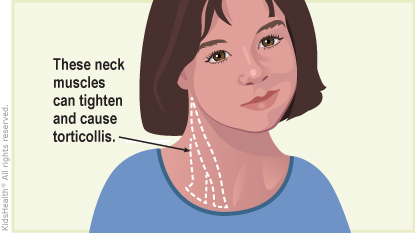Torticollis: How to Care for Your Child
Torticollis (or twisted neck) is when one side of the neck feels tight and is painful to move. It happens when an injury or irritation makes the neck muscles spasm (tighten). In torticollis, the head tilts to one side and the chin to the other side. Symptoms usually improve within a few days with rest and home care.


-
Let your child rest.
-
Have your child avoid movements that strain the neck, like lifting heavy objects or turning the head quickly.
-
You can give medicine for pain. Use these medicines exactly as directed:
-
acetaminophen (such as Tylenol® or a store brand)OR
-
ibuprofen (such as Advil®, Motrin® or a store brand). Do not give to babies under 6 months old.
-
Do not give aspirin to your child or teen, as it can be dangerous.
-
If your health care provider prescribed a medicine to relax the neck muscles, give as directed. This type of medicine can cause sleepiness, so check on your child regularly.
-
Apply a warm cloth or heating pad wrapped in a towel to the painful side of the neck for 20 minutes every 3–4 hours until the pain is better. Never put heat packs directly on the skin.
-
If the health care provider recommended a soft neck collar, have your child wear it only as long as directed. Don't use it during sleep.

Your child:
-
gets a fever
-
can't drink liquids normally
-
is taking a muscle relaxant and becomes very sleepy
-
gets a headache
-
has new pain or stiffness
-
has neck pain when not moving the neck

Your child:

What causes torticollis? Torticollis can happen after an injury, throat infection or cold, or after sleeping in an uncomfortable position. Torticollis can't always be prevented, but helping kids sleep in a comfortable position can help them avoid it.
Are tests done to diagnose torticollis? Tests usually aren't needed to diagnose torticollis. The health care provider diagnoses it by asking questions, finding out what happened, and doing an exam.
Can torticollis happen again? Yes, torticollis can happen again. Call your health care provider any time your child has symptoms of torticollis.